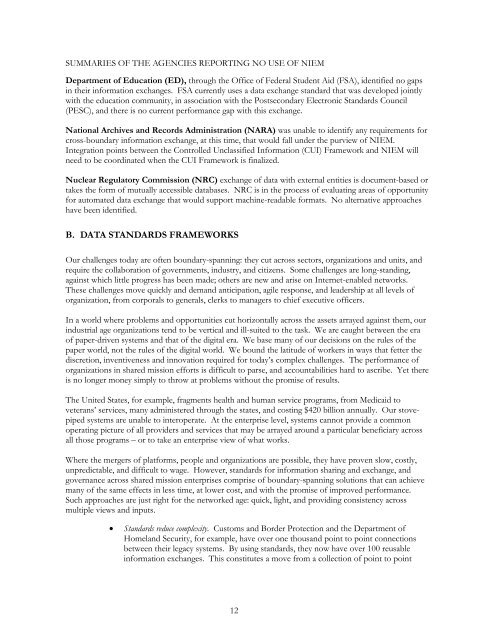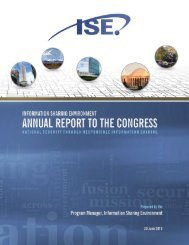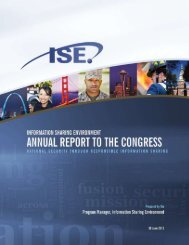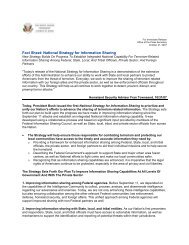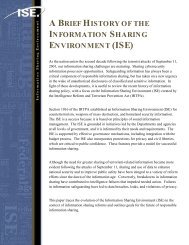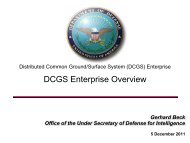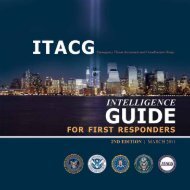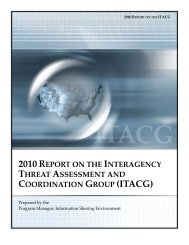agency information exchange functional standards evaluation
agency information exchange functional standards evaluation
agency information exchange functional standards evaluation
You also want an ePaper? Increase the reach of your titles
YUMPU automatically turns print PDFs into web optimized ePapers that Google loves.
SUMMARIES OF THE AGENCIES REPORTING NO USE OF NIEM<br />
Department of Education (ED), through the Office of Federal Student Aid (FSA), identified no gaps<br />
in their <strong>information</strong> <strong>exchange</strong>s. FSA currently uses a data <strong>exchange</strong> standard that was developed jointly<br />
with the education community, in association with the Postsecondary Electronic Standards Council<br />
(PESC), and there is no current performance gap with this <strong>exchange</strong>.<br />
National Archives and Records Administration (NARA) was unable to identify any requirements for<br />
cross-boundary <strong>information</strong> <strong>exchange</strong>, at this time, that would fall under the purview of NIEM.<br />
Integration points between the Controlled Unclassified Information (CUI) Framework and NIEM will<br />
need to be coordinated when the CUI Framework is finalized.<br />
Nuclear Regulatory Commission (NRC) <strong>exchange</strong> of data with external entities is document-based or<br />
takes the form of mutually accessible databases. NRC is in the process of evaluating areas of opportunity<br />
for automated data <strong>exchange</strong> that would support machine-readable formats. No alternative approaches<br />
have been identified.<br />
B. DATA STANDARDS FRAMEWORKS<br />
Our challenges today are often boundary-spanning: they cut across sectors, organizations and units, and<br />
require the collaboration of governments, industry, and citizens. Some challenges are long-standing,<br />
against which little progress has been made; others are new and arise on Internet-enabled networks.<br />
These challenges move quickly and demand anticipation, agile response, and leadership at all levels of<br />
organization, from corporals to generals, clerks to managers to chief executive officers.<br />
In a world where problems and opportunities cut horizontally across the assets arrayed against them, our<br />
industrial age organizations tend to be vertical and ill-suited to the task. We are caught between the era<br />
of paper-driven systems and that of the digital era. We base many of our decisions on the rules of the<br />
paper world, not the rules of the digital world. We bound the latitude of workers in ways that fetter the<br />
discretion, inventiveness and innovation required for today’s complex challenges. The performance of<br />
organizations in shared mission efforts is difficult to parse, and accountabilities hard to ascribe. Yet there<br />
is no longer money simply to throw at problems without the promise of results.<br />
The United States, for example, fragments health and human service programs, from Medicaid to<br />
veterans’ services, many administered through the states, and costing $420 billion annually. Our stovepiped<br />
systems are unable to interoperate. At the enterprise level, systems cannot provide a common<br />
operating picture of all providers and services that may be arrayed around a particular beneficiary across<br />
all those programs – or to take an enterprise view of what works.<br />
Where the mergers of platforms, people and organizations are possible, they have proven slow, costly,<br />
unpredictable, and difficult to wage. However, <strong>standards</strong> for <strong>information</strong> sharing and <strong>exchange</strong>, and<br />
governance across shared mission enterprises comprise of boundary-spanning solutions that can achieve<br />
many of the same effects in less time, at lower cost, and with the promise of improved performance.<br />
Such approaches are just right for the networked age: quick, light, and providing consistency across<br />
multiple views and inputs.<br />
• Standards reduce complexity. Customs and Border Protection and the Department of<br />
Homeland Security, for example, have over one thousand point to point connections<br />
between their legacy systems. By using <strong>standards</strong>, they now have over 100 reusable<br />
<strong>information</strong> <strong>exchange</strong>s. This constitutes a move from a collection of point to point<br />
12


